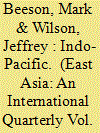|
|
|
Sort Order |
|
|
|
Items / Page
|
|
|
|
|
|
|
| Srl | Item |
| 1 |
ID:
125846


|
|
|
|
|
| Publication |
2013.
|
| Summary/Abstract |
This research investigates whether where we live matters in terms of contributions to direct greenhouse gas (GHG) emissions. Using results from the Halifax Space Time Activity Research (STAR) project, we estimate GHG emissions for 1920 randomly selected respondents in Halifax Regional Municipality, Nova Scotia, Canada. The unique data set allows us to report direct GHG emissions with an unprecedented level of specificity at the sub-regional scale using household energy-use survey data and GPS-verified travel data. We report results and investigate statistical differences between communities and urban-rural zones (inner city, suburban, and inner and outer commuter belts). Results reveal considerable spatial variability in direct GHG emissions across the study area. Our findings indicate that individuals living in the suburbs generate similar amounts of GHG emissions (20.5 kg CO2e person-1 day-1) to those living in the inner city (20.2 kg CO2e person-1 day-1), challenging a widely held assumption that living in the urban centre is better for sustainability. However, individuals in more rural areas have significantly higher transport-related GHG emissions than those living in the inner city and suburbs. Our results underscore the importance of understanding the spatial distribution of GHG emissions at the sub-regional scale.
|
|
|
|
|
|
|
|
|
|
|
|
|
|
|
|
| 2 |
ID:
165200


|
|
|
|
|
| Summary/Abstract |
Infrastructure is an emerging component of Australian diplomacy. In recent years, many infrastructure and connectivity (I&C) programs have been launched in the Indo-Pacific, designed to close the ‘infrastructure gaps’ that plague the region. Competition amongst these, particularly between US and Chinese offerings, has posed a dilemma for Australian foreign policy. Australia has struggled to articulate a policy on China’s Belt and Road Initiative that balances strategic concerns against economic opportunities; while enthusiastic engagement with US alternatives risks perceptions of ‘choosing’ sides between the region’s two main powers. Yet the contemporary marketplace for Indo-Pacific I&C is much broader, with programs recently launched by many governments and regional organisations. These presents an opportunity for Australia to diversify its infrastructure diplomacy, particularly through engagement with the Asian Infrastructure Investment Bank, cooperation with Japan and new avenues for commercial diplomacy. By engaging with a wider range of I&C partners and institutions, Australia can better integrate itself with the emerging infrastructure systems of the Indo-Pacific.
|
|
|
|
|
|
|
|
|
|
|
|
|
|
|
|
| 3 |
ID:
160605


|
|
|
|
|
| Summary/Abstract |
There is nothing natural, timeless, or essential about regions. The very idea of regions is necessarily a comparatively modern artifact of human history. While there is still debate about quite who discovered whom, the general point is clear: until advances in navigation and exploration made connections feasible between geographically remote places, the very idea of different, separate regions was impossible. Without an “other” to be identified in opposition with, no sense of distinct regional identity or boundaries is possible. Even when it became apparent to Europeans that there was an entire “new world” beyond the horizon about which they had only limited or no knowledge, it would take a long time before the contours and boundaries of new regions would be understood and mapped. Significantly, the East Asian part of this unknown world was not only more economically developed, “civilized,” and technologically advanced than Europe [6, 8], but some of the patterns of interaction that existed before European intrusion have had enduring consequences.
|
|
|
|
|
|
|
|
|
|
|
|
|
|
|
|
|
|
|
|
|